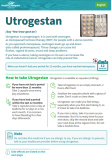Utrogestan belongs to a group of medicines called progestogens and is used, together with oestrogen, as menopausal hormone therapy (MHT) for people who still have their uterus (womb).
As you approach menopause, changes or fluctuations in oestrogen levels can cause symptoms such as sweats or flushes, vaginal dryness, irritability and other mood changes, heart palpitations, 'brain fog' (poor memory or losing your words), skin changes and poor sleep. Read more about menopause.
- Menopause affects people in different ways and symptoms vary hugely in severity.
- You may have very little discomfort, or you may find that your symptoms interfere with your relationships and normal daily activities.
- If you have symptoms which are not relieved by lifestyle adjustments and self-care measures, your healthcare provider will discuss various treatment options with you, including MHT.
- MHT can help to relieve some of the symptoms of menopause and can make a big difference to the quality of life for many people. Read more about menopausal hormone therapy.
Utrogestan is used, together with oestrogen, in people who have a uterus (womb). If you still have your uterus, your MHT will include both oestrogen and progestogen because oestrogen alone can overstimulate the cells lining your uterus, causing an increased risk of cancer of the uterus lining. The progestogen in Utrogestan helps to prevent the thickening of the lining and therefore reduces the risk of cancer.
Is Utrogestan different to other progestogens?
Utrogestan is considered a body identical hormone therapy, because it has the same chemical structure as the natural female hormone progesterone. Evidence suggests that this formulation has fewer long-term side effects.
Factsheet: How to take Utrogestan

|
Utrogestan factsheet |









